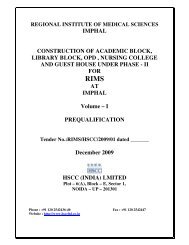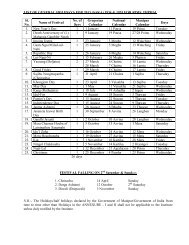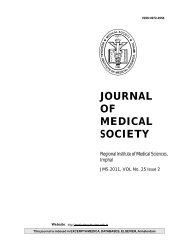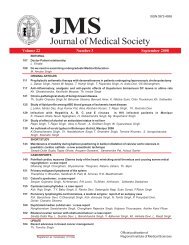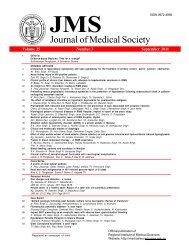Evidence-based Medicine: Time for a change? - Journal of Medical ...
Evidence-based Medicine: Time for a change? - Journal of Medical ...
Evidence-based Medicine: Time for a change? - Journal of Medical ...
You also want an ePaper? Increase the reach of your titles
YUMPU automatically turns print PDFs into web optimized ePapers that Google loves.
ORIGINAL ARTICLE<br />
Attention deficit hyperactivity disorder (ADHD) in a school sample in Manipur<br />
1<br />
R.K. Lenin Singh, 2 S. Gojendra Singh, 3 L. Roshan Singh, 4 N. Heramani singh, 5 M. Akshyakumar Singh<br />
Abstract<br />
Objective: To find out the prevalence <strong>of</strong><br />
ADHD among the school children in a city<br />
school, Imphal, Manipur. Methods: A total <strong>of</strong><br />
312 students within the age range <strong>of</strong> 5-12<br />
years were evaluated by using Vanderbilt<br />
ADHD Diagnostic Teacher Rating Scale and<br />
Vanderbilt ADHD Diagnostic Parents Rating<br />
Scale. Results: The prevalence <strong>of</strong> ADHD was<br />
estimated to be 4.17% and the rate was higher<br />
among boys than girls with a percentage <strong>of</strong><br />
2.9% and 1.8% respectively. Conclusion:<br />
ADHD is common among the school children<br />
in Manipur.<br />
Keywords: Prevalence, attention deficit<br />
hyperactivity disorder, school children<br />
Introduction: Attention-deficit/hyperactivity<br />
disorder (ADHD) has defining features <strong>of</strong><br />
inattention, over activity, and impulsivity 1 . It is<br />
the most frequently encountered childhoodonset<br />
neurodevelopment disorder in primary<br />
care settings.<br />
Symptoms frequently co-occur with other<br />
emotional, behavioral, and learning problems,<br />
including oppositional defiant disorder,<br />
conduct disorder, depression, anxiety, and<br />
learning disabilities.<br />
1. Associate pr<strong>of</strong>essor, 2. Registrar, Dept. <strong>of</strong><br />
psychiatry, 3. Assistant Pr<strong>of</strong>essor, Dept. <strong>of</strong> Clinical<br />
Psychology, 4. Pr<strong>of</strong>essor & Head, Dept. <strong>of</strong><br />
Psychiatry 5. Pr<strong>of</strong>essor, Dept. <strong>of</strong> Clinical<br />
Psychology<br />
Correspondence: Dr. R.K.Lenin Singh, Associate<br />
Pr<strong>of</strong>essor, Department <strong>of</strong> Psychiatry, RIMS, Imphal<br />
Email Address: leninrk@yahoo.com<br />
Introduction: Attention-deficit/hyperactivity<br />
disorder (ADHD) has defining features <strong>of</strong><br />
inattention, over activity, and impulsivity 1 . It is<br />
the most frequently encountered childhoodonset<br />
neurodevelopment disorder in primary<br />
care settings. Symptoms frequently co-occur<br />
with other emotional, behavioral, and learning<br />
problems, including oppositional defiant<br />
disorder, conduct disorder, depression,<br />
anxiety, and learning disabilities. The National<br />
Institute <strong>of</strong> Mental Health (NIMH), estimates<br />
that between 3% and 5% <strong>of</strong> preschool and<br />
school-age children have ADHD or<br />
approximately two million children in the<br />
United States. This means in a class <strong>of</strong> 25 to<br />
30 students, it is likely that at least one student<br />
will have this common condition 2 . The cause<br />
<strong>of</strong> ADHD is unknown, and multiple pathways<br />
may lead to the phenotypic expression <strong>of</strong> the<br />
disorder 3 . Some studies suggest that genes<br />
play a large role. Like many other illnesses,<br />
ADHD probably results from a combination<br />
<strong>of</strong> factors. In addition to genetics, researchers<br />
are looking at possible environmental factors,<br />
and are studying how brain injuries, nutrition,<br />
and the social environment might contribute<br />
to ADHD. Results from several international<br />
studies <strong>of</strong> twins show that ADHD <strong>of</strong>ten runs<br />
in families. Researchers are looking at several<br />
genes that may make people more likely to<br />
develop the disorder 4,5 . Children with ADHD<br />
who carry a particular version <strong>of</strong> a certain gene<br />
have thinner brain tissue in the areas <strong>of</strong> the<br />
brain associated with attention. This National<br />
Institute <strong>of</strong> Mental Health (NIMH) research<br />
showed that the difference was not<br />
46 JMS * JMS Vol 25 * Vol * No. 25 3 * No. * September, 1 * June, 2010 2011










